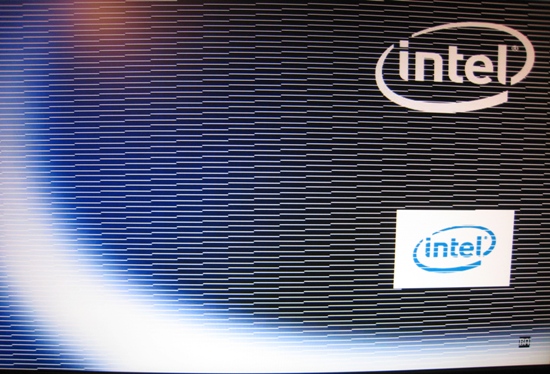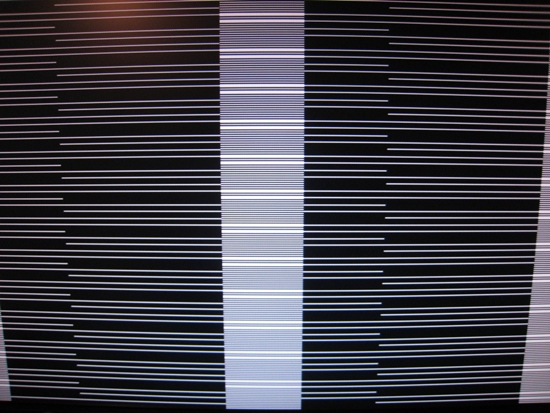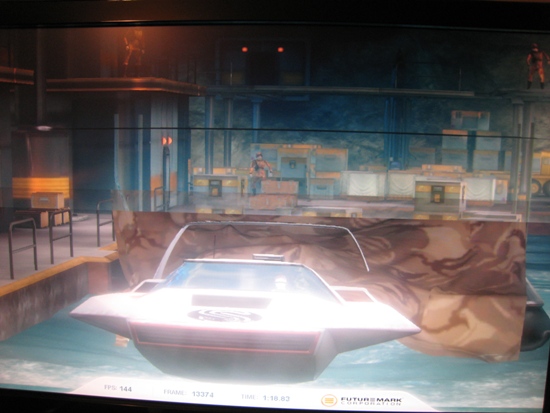Velocity Micro Edge Z55: Core i7-940 with CrossFire 4870
by Matt Campbell on December 12, 2008 2:00 AM EST- Posted in
- Systems
Problems
We don't always have much of substance to put in our "Problems" section, but being one of the earliest launch systems of Core i7, we had our fair share of trouble with the Z55.
When our system first arrived a few days before the November 17 launch date, we eagerly delved into testing. As with romance, at first everything seemed wonderful; then problems started to appear. Though stable enough to complete a 3DMark run, Prime95 would crash the system in less than an hour (sometimes within 5 minutes). Though high, temperatures were within the range of operation, and regardless thermal throttling should kick in for CPU heat issues. We tried a number of small tweaks and spent some time on the phone with Mario at Velocity Micro, the builder for our system. Ours was the only review system reporting problems, and after stepping through some other ideas, they decided the most expedient solution to save us troubleshooting time was to get us another system. In speaking with Mario, we were impressed with his knowledge and VM's test methodology.
While waiting, we decided to wipe VM's BIOS settings and start from scratch. After hours of testing, we had the system rock-solid at 3.3GHz, but only at low memory speeds (600MHz). The system became very unstable at higher rates. While building us the new system, Mario informed us he saw an identical problem with a certain batch of RAM. However, the new system that we received had identical batch numbers to that of our "old" system.

Once we received our new system (which by this time was shipping to hundreds of customers), we expected our problems to largely disappear. However, as soon as we booted up we had a new set of issues. This is the screen we were greeted with:

Or more like this, later on in the boot cycle:

Great. Diving back into troubleshooting, the first thing we tried (after removing one of the 4870s) was altering the PCIe Latency Timer setting in the (updated) BIOS, which Mario had previously told us is very problematic with ATI cards and specifically CrossFire setups. A setting of 192 stabilized the system, but we were still getting a little screen corruption and crashing in CrossFire mode. Scavenging and swapping in the two cards from our previous system seemed to solve our problems, and system testing was started. Midway through our benchmarking, however, we noticed some performance issues, and that CrossFire was no longer showing up in the Catalyst Center. A quick look in Device Manager showed one of our cards with a yellow exclamation point - it was disabled due to a "Code 43" error. Our CrossFire setup was only using one 4870!
Forcing the video card back on, reinstalling the ACPI driver (a suggestion found in several forums on the Code 43 topic with ATI cards), a few reboots, and a 10" desk fan pointing into the chassis to alleviate any heat problems stabilized the system enough to collect some results on the 8.11 drivers.

However, with the host of problems we'd run into, and being a new chipset platform, we also wanted to try the latest and greatest drivers, and installed the 8.12 beta from ATI. In general, they made the system a little more predictable but it still exhibited some problems, particularly in 3DMark where we saw some graphics corruption.

Overall, it seemed like the system had a lot of potential, but couldn't follow through when it came to stability. Whether this was caused by the early nature of the hardware (very likely), inadequate CPU cooling (also likely), or something else, the fact remains that anyone buying a new high-end system would be very unhappy if it failed to run properly. Then again, it's called the bleeding edge for good reason.










27 Comments
View All Comments
gohorns79 - Thursday, December 18, 2008 - link
I just ordered a Z55 system from VM. I usually build but I just don't have the time anymore so I'm leaving it to the pros. I'm very excited about it. If you would like to hear my first impressions of an actual system (not a review system) let me know and I can take some pics and describe the experience.gohorns79 - Thursday, December 18, 2008 - link
I just ordered a Z55 system from VM. I usually build but I just don't have the time anymore so I'm leaving it to the pros. I'm very excited about it. If you would like to hear my first impressions of an actual system (not a review system) let me know and I can take some pics and describe the experience.Mario Cifaldi - Monday, December 15, 2008 - link
Hey guys. This was a very exhaustive review and I really enjoy seeing this kind of depth in testing and documentation.Some things I need to point-out that can easily go overlooked:
Cooling:
The stock HSF used in this review was all that was ‘available’ at the time this review system was constructed. The only other aftermarket coolers that were available were not suitable for this case as there were risks of clearance issues or they were simply too loud (as seen with some of the server coolers for 1366). This is all we had to choose from. Options were extremely limited here but rest assured we are very aware of thermals and requirements as well as how much further these CPU’s can go. This is what the Overdrive PC brand caters more to. In the end, the stock cooler sufficed and suffices for this system and current shipping systems running 3.2GHz as it stays well-below Tjunction.
Scope:
This was not ever intended to be an extreme overclocker nor were we trying for greater speeds than 3.2GHz. This was a very simple OC on a mid-range system. Because we are also selling this system retail (with the stock cooler), we cannot offer speeds outside of that for the same SKU so that is why we did not dial-up this system’s speed any higher for this single review.
Networking:
The ‘fixed’ IP on this system was simply for my internal connectivity needs and is not a standard on (any) VM/OPC systems. This was a trivial point as I understand but I just wanted to clarify that this was specific to these two review machines.
Memory Batch Codes:
As far as the batch code of memory (where we sent in a duplicate set), this was a simple mistake from the result of assuming the first set I sent was code ‘045’. I felt I was certain I explained this ‘045’ code to Matt but apparently there was a mis-communication. Because I was certain the first batch code must have been ‘045’ due to similar memory issues we’ve seen in-house with this batch code, I felt confident that I sent a new code of ‘051’ out to Matt. This was a simple mistake and obviously I would not knowingly send a duplicate code intentionally.
Memory Voltage:
1600MHz Corsair memory requires 1.8V’s to support ‘stock’ speeds and I dialed the memory voltage at 1.9V’s due to a 10% OC. Logical. As far as Intel’s warning about voltages beyond 1.65V, we have yet to see any issues with exceeding this and in the interim, we’re not offered too many options for (not) using voltages beyond this point if the customer requests 1600Mhz memory.
CrossFire and Smack Over:
We’ve seen anomalies with this new Intel board and CrossFire and most have been resolved with PCI Latency adjustments as I explained to Matt. At the time this replacement system shipped, there were no anomalies with CrossFire and all graphic tests passed 100%. This is apparently an intermittent issue and we’ve made Intel aware of it recently. I hope it’s implied that we would not have shipped another system with issues right-out-of-the-box having been afforded the opportunity to resolve the first system with a replacement.
I’ll continue to follow this thread if anyone has questions or comments and again VM thanks AnandTech for such an in-depth look at our organization and systems. :)
BikeDude - Monday, December 15, 2008 - link
(is this the right Quote tag? The toolbar in the editor seems broken for the past few days)Thanks for the followup Mario.
The article mentioned "PCIe latency". I guess you were misquoted. (happens a lot of course) I apologize for believing otherwise.
If PCI latency adjustment helped, then I would postulate that there are some timing issues somewhere that are not what they should be. Either issues in the driver (did you observe any BSODs?) or the hardware itself. It is not supposed to be so finicky! After all, why should a PCIe device be bothered with adjustments that only affect devices on the PCI bus? It makes absolutely no sense. Intel and/or AMD has some serious homework to do now if you have observed this anomaly in several systems.
Mario Cifaldi - Monday, December 15, 2008 - link
I have had to hand-tune several of the Smack Over boards for "PCI Latency" to stabilize the graphic anomalies seen in CrossFire mode. From time to time I would see a BSOD after letting the anomalies run for a period of time. This issue was never isolated to be an OC'ing issue either. Both cards run 100% fine by themselves in the top slot, but enabling CrossFire on both cards has required PCI Latency adjustment of 128-248 depending on the pair of cards used.Here is a revision to the sentence you mentioned above: "We’ve seen anomalies with this new Intel board and CrossFire. Most of these anomalies have been resolved with PCI Latency adjustments as I explained to Matt."
BikeDude - Sunday, December 14, 2008 - link
[quote]Diving back into troubleshooting, the first thing we tried (after removing one of the 4870s) was altering the PCIe Latency Timer setting in the (updated) BIOS, which Mario had previously told us is very problematic with ATI cards and specifically CrossFire setups.[/quote]First of all, I was surprised, because I thought the days of tweaking latency settings were long gone. After all, with PCI the latency setting would dictate how long a given device were allowed to control the bus. With PCIe, I thought each device had separate serial lanes to the chipset and that latency settings were now obsolete.
So obviously I do not have the necessary insight into what goes on in the PCIe world, but I do find it odd to start tweaking such settings when the graphics is FUBAR already during POST. IMO, no setting in the BIOS should be able to FUBAR the graphics cards. That smells of either a broken motherboard or broken graphics cards. (besides, back in the day, the latency setting mostly affected sound cards that depended on delivering a steady stream of audio to the speakers -- I do not recall hearing of corruption issues with GPUs... Only pure fps performance issues)
If tweaking PCIe latency settings did any difference at all in that situation, then I would chalk it up to dumb luck. I would certainly not use this as my first troubleshooting step in the future. Something is very, very wrong in that situation. Me thinks Mario has come across quite a few bad ATI based cards, and that instead of changing them for a batch of good ones, some bandaid was applied and now they hum along by sheer coincidence.
And temperature issues? In a new rig like this? Intel's CPUs have, for a long time now, boasted of speedstepping technology that would slow down the CPU in case of overheating. So even mentioning the possibility of an overheating CPU causing issues... [quote]inadequate CPU cooling (also likely)[/quote]
I feel the article is a bit weak on theory and quite strong on "let us see if some gum will solve this". Please start from square one with this one. I want to know if Mario's suggestions even made any sense at all.
ikjadoon - Friday, December 12, 2008 - link
Hi, guys. I own an Overdrive PC, the Core2.SLI. Definitely hand-built by the same Mario Cifaldi Anandtech talked with; the guy is the epitome of the enthusiast crowd. He was selling the Q9550 @ 3.7GHz, if I recall correctly, but now, obviously he's moved onto the i7s.They have fantastic build quality; shame you didn't take some pictures of the wiring. Those outside shots don't do justice. :)
I'd chalk up some of the missing items and stability issues to being a pre-production system because these guys are the very best. Every review I've heard of Overdrive PC is absolutely glowing; now that they've merged, some of the better parts of OPC are working with VM, too, and vice-versa, hence the overclocking.
Anyways, great review.
I'd love to see an OPC review soon. :)
bob4432 - Friday, December 12, 2008 - link
maybe i have been building computers for too many years, but $4K on a computer is ridiculous. i am not trying to be a dick but honestly, who pays that much for the performance you could get easily at 1/2-1/3 the cost?4wardtristan - Monday, December 15, 2008 - link
people who havent been building omputers for many years?Nihility - Friday, December 12, 2008 - link
System restore is a necessary component of shadow copy in vista business/ultimate. As a user, shadow copy has saved my files on more than one occasion.I also find system restore is the easiest solution when your computer doesn't boot due to OS corruption or a virus. The space it takes on a hard drive today costs almost nothing (what's a few gigs?).
There's really no reason to shut it off. During benchmarks maybe but not for normal use.